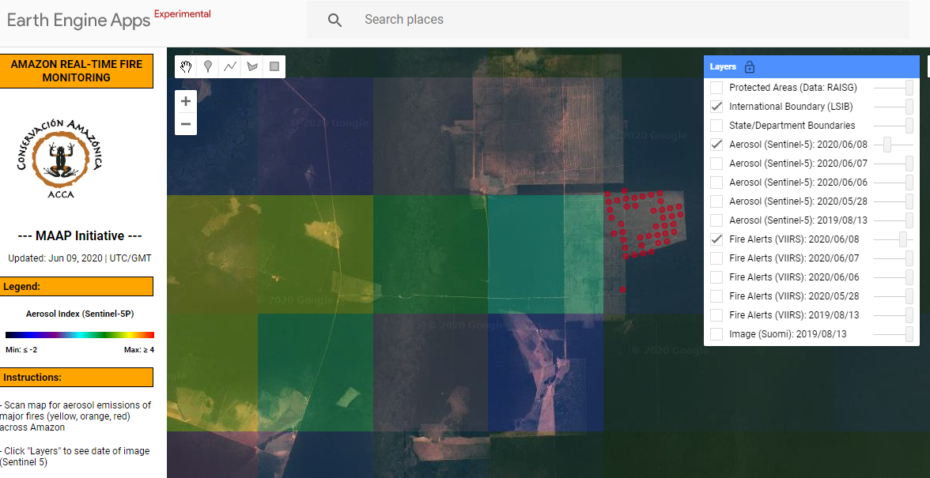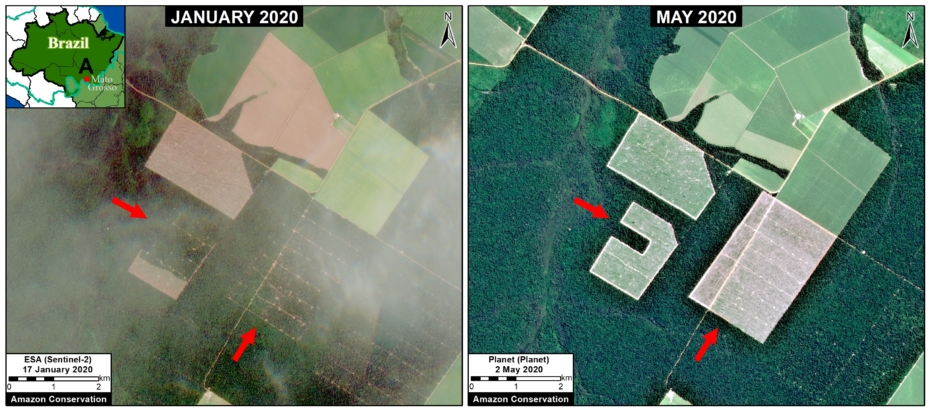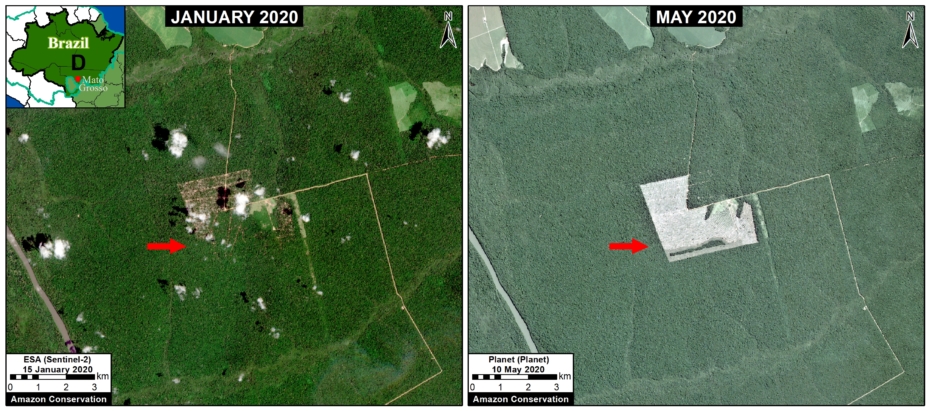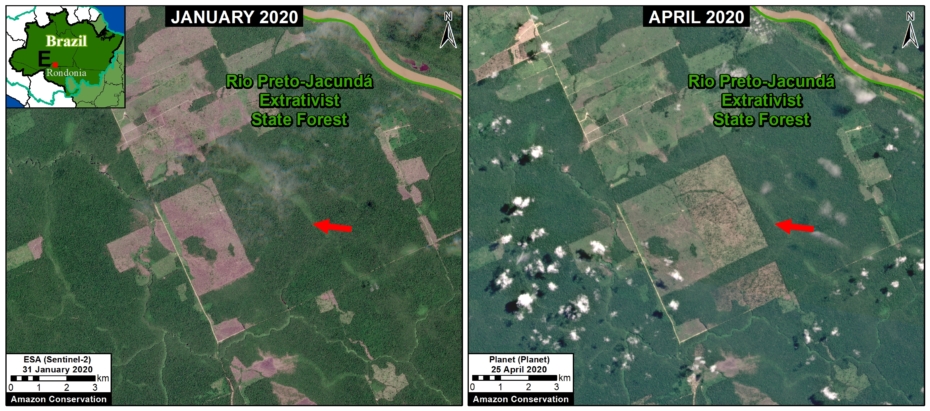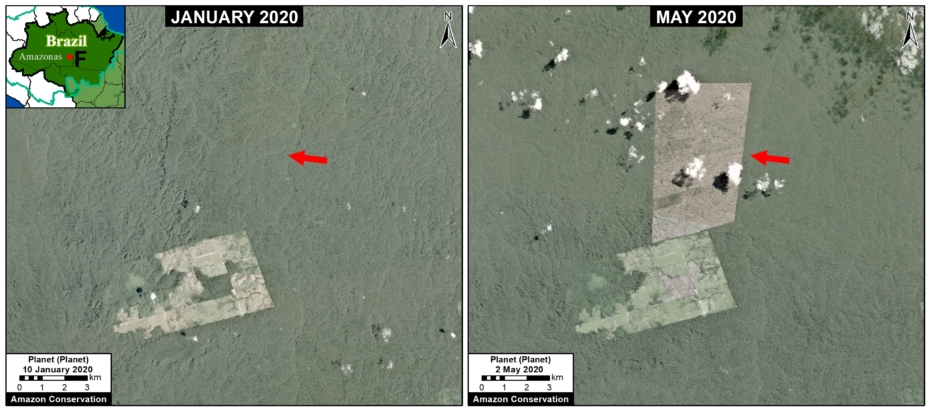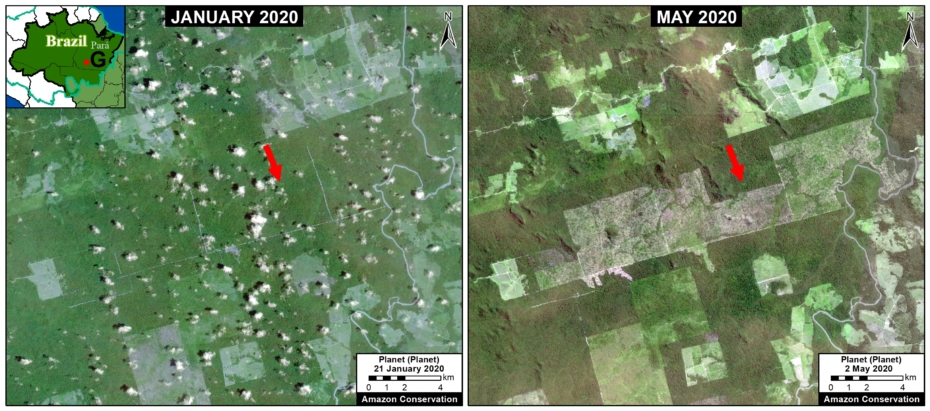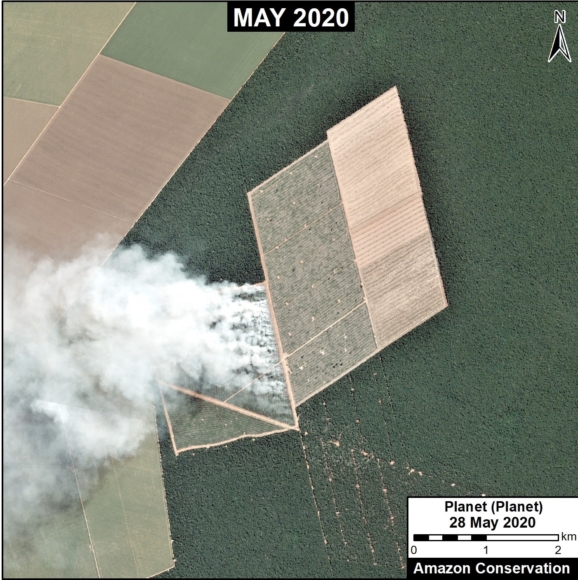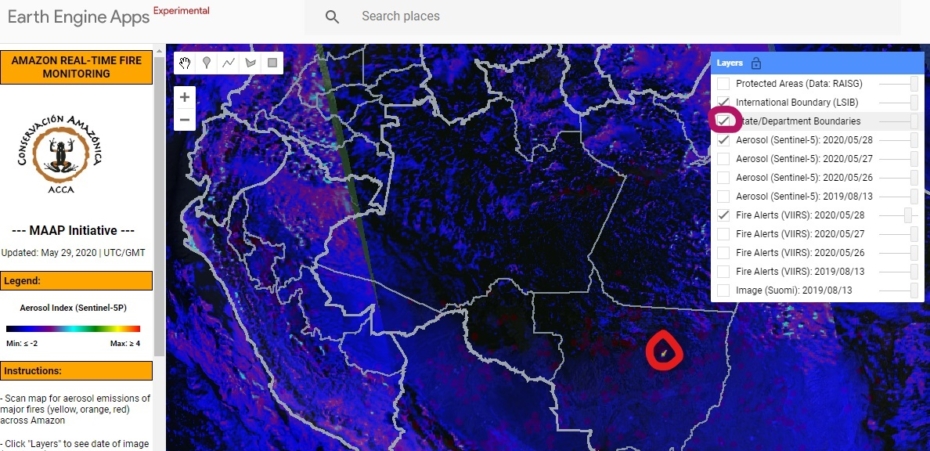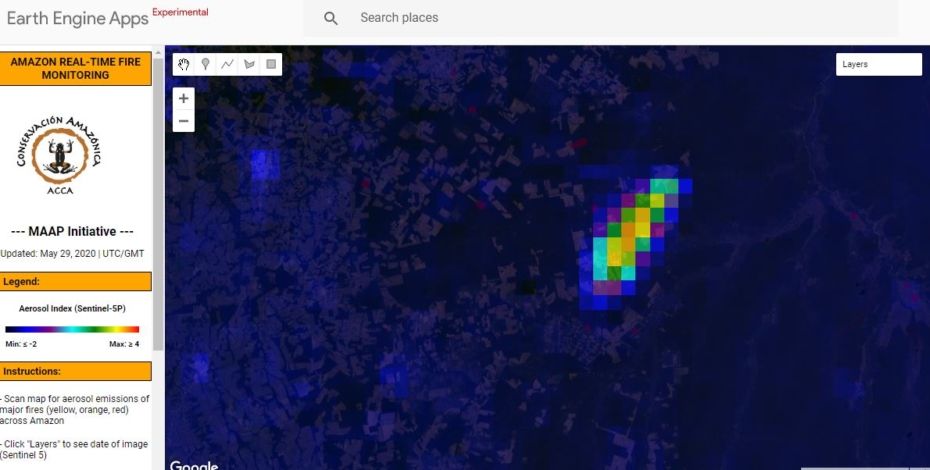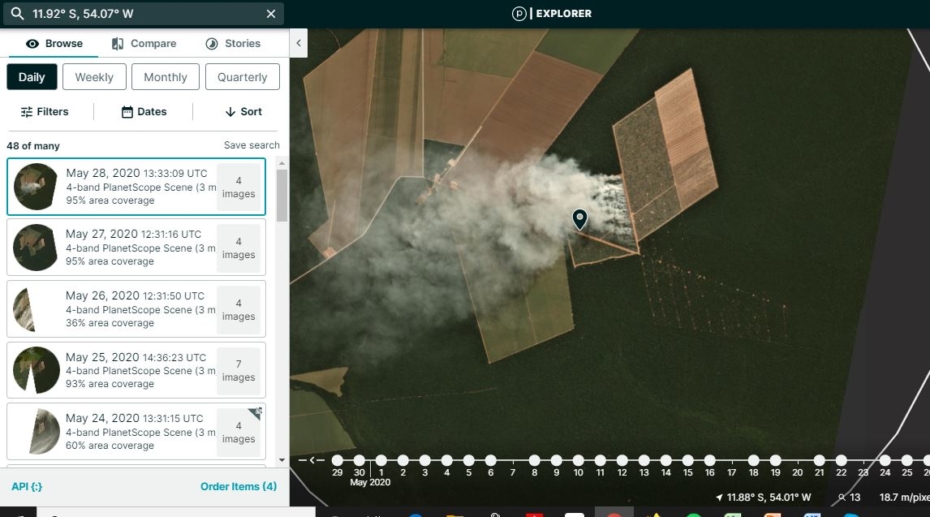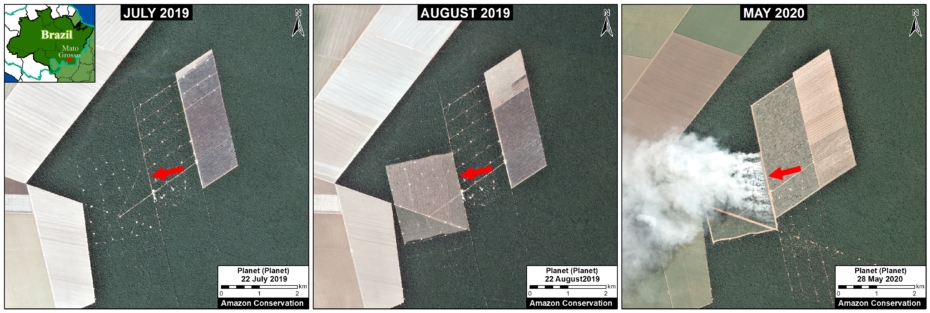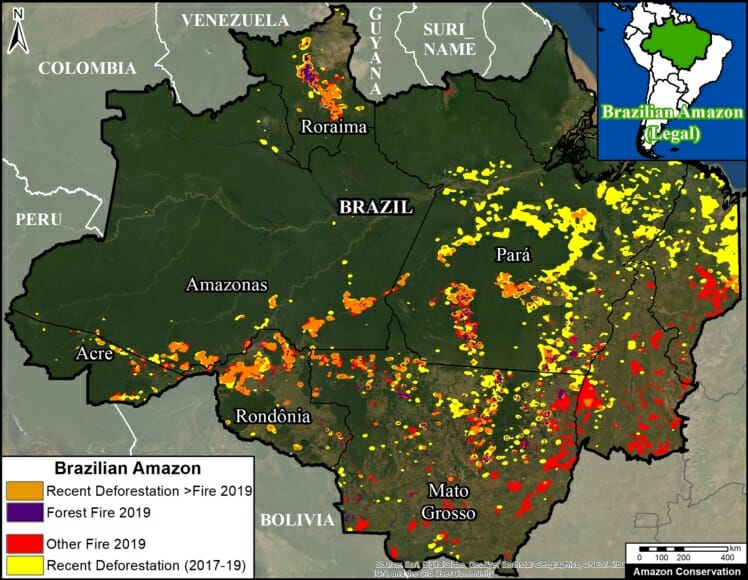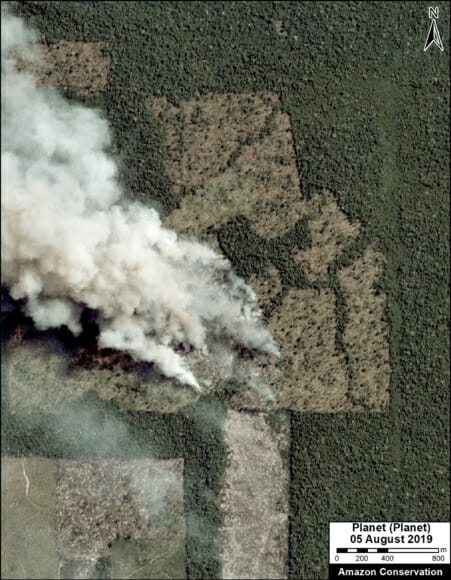See MAAP #118 for background information about real-time fire monitoring work.
Fire
Amazon Fire Tracker 2020: Brazil Fire #12 (June 29)
As presented in MAAP #118, Amazon Conservation launched a real-time fire monitoring app that specializes in the rapid and user-friendly detection and visualization of major Amazon fires.
In a novel approach, the app combines data from the atmosphere (aerosol emissions in smoke) and the ground (heat anomalies) to effectively monitor large Amazon fires.
As detailed below, the app just detected the 12th major Amazon fire of the year on June 29, 2020 (see the high-resolution image to the right).
It burned 587 hectares (1,451 acres) of land deforested in 2019.
Thus far, all 12 major Amazon fires of 2020 have:
- Occured in the state of Mato Grosso, in the southeastern Brazilian Amazon.
- Burned recently deforested areas (that is, areas deforested in 2018, 2019, or 2020). In other words, these are not forest fires. See MAAP #113 for background on this important point.
Below, we describe the process of using the app to detect and confirm the fire on June 29.
Step 1. Detection of elevated emissions in the southeastern Brazilian Amazon (Mato Grosso).
Step 2. Zoom in to confirm the elevated aerosol emissions, indicating the burning of abundant biomass.
Step 3. Adjust the transparency to see the underlying fire alerts that indicate the exact location of the fires. Obtain coordinates of the source of the fires.
Step 4. Confirm fire with satellite imagery. For example, here is a high resolution image from Planet Explorer showing the fire burning on June 29.
Step 5. Using Planet’s extensive imagery archive, we were able to determine that the fires were burning an area deforested in 2019 (and not a forest fire). In the timelapse below, see that the deforestation occurred between September and October 2019, and then burned on June 29, 2020. The final image shows the day after the fires, June 30, to see the full extent of the burn.
Coordinates
-10.99, -55.13
References
Acknowledgements
This work was supported by the following major funders: USAID/NASA (SERVIR), Global Forest Watch Small Grants Fund (WRI), Norwegian Agency for Development Cooperation (NORAD), International Conservation Fund of Canada (ICFC), Metabolic Studio, and Erol Foundation.
Citation
Finer M, Villa L (2020) Amazon Fire Tracker 2020: Brazil #12 (June 29). MAAP.
Amazon Fire Tracker 2020: Brazil #4 (June 17, 2020)
As presented in MAAP #118, Amazon Conservation launched a real-time fire monitoring app that specializes in detection of elevated aerosol emissions in the smoke coming from burning Amazon fires. As detailed below, the app just detected the fourth major Amazon fire of 2020 on June 17. All four fires thus far have been in the state of Mato Grosso and burning recently deforested areas (see MAAP #113 for background).
Step 1. Detection of elevated emissions in the southeastern Brazilian Amazon (Mato Grosso).
Step 2. Zoom in on the emissions.
Step 3. Adjust the transparency to see the underlying fire alerts that indicate the exact location of the fires. Obtain coordinates of the source of the fires.
Step 4. Check the satellite imagery in Planet Explorer. Here is a high resolution Planet image showing the fire burning on June 17. Also see the slider below, comparing the the June 17 fires with a pre-fire image from June 10.
[twenty20 img1=”9167″ img2=”9168″ width=”75%” offset=”0.5″]
Imagery source: Planet.
Step 5. Using Planet’s extensive imagery archive, we were able to determine that the fires were burning an area deforested in 2019 (and not a forest fire).
Coordinates: -10.45, -53.55
Annex – Fire Alert vs. Aerosol Emission Data
This slider shows us how aerosol emission data allows users to prioritize hundreds (or thousands) of heat-based fire alerts. In other words, the aerosol data indicates just the fires that are actually burning lots of biomass and putting out abundant smoke.
[twenty20 img1=”9170″ img2=”9169″ offset=”0.5″]
References
Acknowledgements
This work was supported by the following major funders: USAID/NASA (SERVIR), Global Forest Watch Small Grants Fund (WRI), Norwegian Agency for Development Cooperation (NORAD), International Conservation Fund of Canada (ICFC), Metabolic Studio, and Erol Foundation.
Citation
Finer M, Villa L (2020) Amazon Fire Tracker 2020: Brazil #4 (June 17, 2020). MAAP.
Fire Alert vs. Aerosol Emission Data
Fire Alert vs. Aerosol Emission Data
This slider shows us how aerosol emission data allows users to prioritize hundreds (or thousands) of heat-based fire alerts. In other words, the aerosol data indicates just the fires that are actually burning lots of biomass and putting out abundant smoke.
[twenty20 img1=”9170″ img2=”9169″ offset=”0.5″]
MAAP: Amazon Fire Tracker #2 – Brazil, June 8 2020
As presented in MAAP #118, Amazon Conservation launched a real-time fire monitoring app that specializes in detection of elevated aerosol emissions from burning Amazon fires. As detailed below, the app detected the second major 2020 fire on June 8, 2020 in Mato Grosso, Brazil.
Step 1. Detection of elevated emissions in the southeastern Brazilian Amazon (Mato Grosso).
Step 2. Zoom in on the emissions, adjust the transparency to see the underlying fire alerts that indicate the fire location.
Step 3. Zoom in again to see precisely the fire location and obtain coordinates.
Step 4. Check the satellite imagery archive in Planet Explorer. Here is a Landsat image (30 meter resolution) showing the fire burned around 3,000 hectares (7,400 acres) of an area deforested in July 2018. Note that MAAP #113 made the important discovery that most of the 2019 Brazilian Amazon fires were burning recently deforested areas (and not uncontrolled forest fires).![]()
Coordinates
References
Acknowledgements
This work was supported by the following major funders: USAID/NASA (SERVIR), Global Forest Watch Small Grants Fund (WRI), Norwegian Agency for Development Cooperation (NORAD), International Conservation Fund of Canada (ICFC), Metabolic Studio, and Erol Foundation.
Citation
Finer M, Villa L (2020) Amazon 2020 Fire Tracker #2 – Brazil, June 8. MAAP.
MAAP #119: Predicting 2020 Brazilian Amazon Fires

The Brazilian Amazon fires made international headlines last year.
By analyzing an archive of satellite imagery (from Planet Explorer), we made the major discovery that many of the 2019 fires were actually burning recently deforested areas (MAAP #113). In fact, many of the fires were burning areas deforested earlier that same year of 2019.
Thus, we may predict 2020 fire locations based on identifying major deforestation events in the early months of this year.
Using a novel methodology*, we estimate the deforestation of over 150,000 hectares (373,240 acres) of primary forest in the Brazilian Amazon thus far in 2020 (through May 25). Thus, there is high potential for another intense fire season.
Below, we illustrate the process of predicting 2020 fires based on recent deforestation.
Note: In MAAP #118 we just reported that the first major fires of 2020 were in fact burning recently deforested areas (2018-19).
Predicting 2020 fires
In the Base Map, the yellow dots indicate the largest new deforestation events that we predict are likely 2020 fire locations. See below for satellite imagery examples (letters A-G). Two of the likely fire points are within protected areas (see Annex).
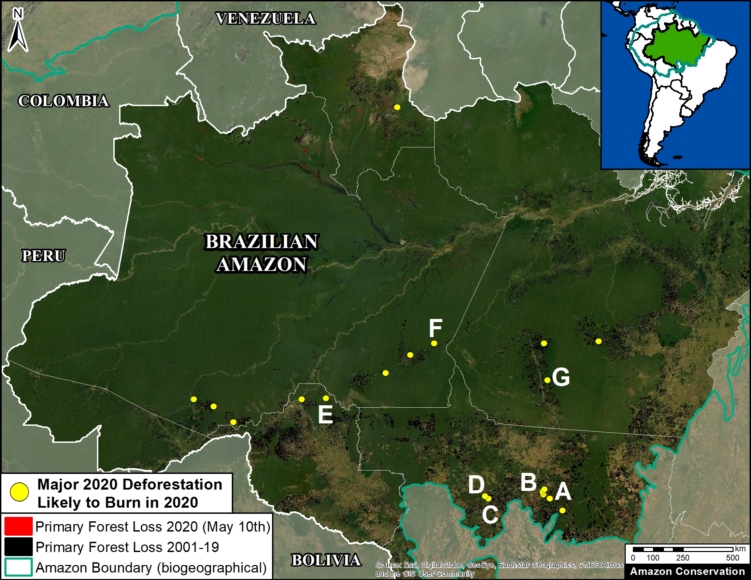
Examples of Major 2020 Deforestation Events
Below is a series of images showing the major deforestation events of 2020 that we predict are likely upcoming fire locations (see letters A-G on the Base Map above for context). The red arrows point to the major deforestation events. Note that all of the deforestation areas are surrounded by primary forest that could be impacted if fires escape. Also note that several deforestation areas are quite large, over 2,000 hectares (5,000 acres).
Zoom A (Mato Grosso)
Zoom A shows the deforestation of 775 hectares (1,915 acres) between January (left panel) and May 2020 (right panel), in the state of Mato Grosso.
Zoom B (Mato Grosso)
Zoom B shows the deforestation of 205 hectares (510 acres) between January (left panel) and May 2020 (right panel), in the state of Mato Grosso.
Zoom C (Mato Grosso)
Zoom C shows the deforestation of 395 hectares (980 acres) between January (left panel) and May 2020 (right panel), in the state of Mato Grosso.
Zoom D (Mato Grosso)
Zoom D shows the deforestation of 300 hectares (735 acres) between January (left panel) and May 2020 (right panel), in the state of Mato Grosso.
Zoom E (Rondônia)
Zoom E shows the deforestation of 840 hectares (2,075 acres) between January (left panel) and April 2020 (right panel), in the state of Rondônia.
Zoom F (Amazonas)
Zoom F shows the deforestation of 2,395 hectares (5,920 acres) between January (left panel) and May 2020 (right panel), in the state of Amazonas.
Zoom G (Pará)
Zoom G shows the deforestation of 5,990 hectares (14,800 acres) between January (left panel) and May 2020 (right panel), in the state of Pará.
Coordinates
World Eckert IV (Decimal Degrees) (X,Y)
Zoom A: -54.862624, -11.971904
Zoom B: -55.087026, -11.836788
Zoom C: -56.999405, -11.979054
Zoom D: -57.128192, -11.896948
Zoom E: -62.658907, -8.477944
Zoom F: -58.892358, -6.567775
Zoom G: -54.948419, -7.853721
2020 Fire Forecast
The July – September 2020 forecast points to an active fire season in most of the western Amazon – much of central and southern Peru, northern Bolivia and the Brazilian states of Acre and Rondônia. This year’s forecast indicates an active fire season of similar magnitude to those of 2005 and 2010, when widespread fires were observed in the region.
To more information check:https://firecast.cast.uark.edu/
Annex – Likely 2020 fire locations in relation to Protected Areas and Indigenous Territories
Methodology
*We developed a novel methodology to estimate deforestation of primary forest in the Brazilian Amazon. For 2020 data, we merged confirmed GLAD alerts (University of Maryland) with select DETER alerts from the Brazilian space agency (INPE). This methodology takes advantage of the higher resolution of the GLAD alerts (30 meters vs 64 meters from DETER), but also the national expertise of the Brazilian government.
For the DETER data, we used the three deforestation and mining categories (DESMATAMENTO CR, DESMATAMENTO Vegetal, and MINERACAO). We avoided overlapping areas with the GLAD alerts.
Finally, we filtered the data for only primary forest loss. For our estimate of primary forest loss, we intersected the forest cover loss data with the additional dataset “primary humid tropical forests” as of 2001 (Turubanova et al 2018). We also removed all previous forest loss data 2001-19.
Acknowledgements
We thank J. Beavers, S. Novoa, K. Fernandes, and G. Palacios for helpful comments to earlier versions of this report.
This work was supported by the following major funders: Global Forest Watch Small Grants Fund (WRI), Norwegian Agency for Development Cooperation (NORAD), International Conservation Fund of Canada (ICFC), Metabolic Studio, and Erol Foundation.
Citation
Finer M, Mamani N (2020) Deforestation and Fires in the Brazilian Amazon – 2020. MAAP:
MAAP #118: Aplicativo de monitoramento de incêndios na Amazônia em tempo real
A tempo para a próxima temporada de incêndios, estamos relançando uma versão aprimorada do nosso aplicativo de monitoramento de incêndios em tempo real da Amazon , hospedado pelo Google Earth Engine.
Quando os incêndios queimam, eles emitem gases e aerossóis.* Um novo satélite (Sentinel-5P da Agência Espacial Europeia) detecta essas emissões de aerossóis .*
O principal recurso do aplicativo é a identificação fácil de usar e em tempo real de grandes incêndios na Amazônia, com base nas emissões de aerossóis detectadas pelo Sentinel-5P.
Como os dados são atualizados diariamente e não são impactados por nuvens, o monitoramento em tempo real realmente é possível. Nossa meta é carregar a nova imagem de cada dia até a meia-noite.
Usando o aplicativo, identificamos recentemente o primeiro grande incêndio na Amazônia de 2020 em 28 de maio, no estado do Mato Grosso, no Brasil. Ele estava queimando uma área recentemente desmatada em julho de 2019.
Abaixo, fornecemos instruções sobre como usar o aplicativo, usando o incêndio de 28 de maio como exemplo.
Instruções e
como identificamos o primeiro grande incêndio na Amazônia brasileira em 2020
Etapa 1. Abra o aplicativo de monitoramento de incêndios em tempo real , hospedado pelo Google Earth Engine. Examine a Amazônia em busca de emissões de aerossóis de grandes incêndios (indicados em amarelo, laranja e vermelho ). Neste caso, identificamos emissões elevadas no sudeste da Amazônia brasileira (em 28 de maio de 2020).
Etapa 2. Clique no menu “ Layers ” no canto superior direito para mais opções. Por exemplo, clicando em “ State/Department Boundaries ” vemos que as emissões estão vindo do Mato Grosso. Note que você também pode adicionar “ Protected Areas ” e verificar as datas das imagens e alertas.
Etapa 3. Aumente o zoom nas emissões de aerossóis.
Etapa 4. Ajuste (deslize para baixo) a transparência da camada de emissões para ver os alertas de incêndio subjacentes . Usamos os alertas para localizar a fonte das emissões (veja o círculo roxo). Obtenha as coordenadas dos alertas clicando no mapa e, em seguida, verificando a barra “Coordenadas” à esquerda (abaixo das Instruções).

Etapa 5. Entramos com as coordenadas no Planet Explorer e encontramos uma imagem de alta resolução para o mesmo dia (28 de maio), confirmando o primeiro grande incêndio na Amazônia de 2020. A área queimada foi de 357 hectares (882 acres).
Previsão dos incêndios na Amazônia brasileira em 2020
Usando o arquivo Planet, descobrimos que essa área exata foi desmatada entre julho e agosto de 2019 e depois queimada em maio de 2020. Isso se encaixa em nossa descoberta importante recente de que muitos incêndios na Amazônia brasileira estão, na verdade, queimando áreas recentemente desmatadas ( MAAP #113 ). Para mais informações sobre como prever incêndios futuros com base no desmatamento recente, consulte MAAP #119 .
Previsão de incêndios para 2020
A previsão de julho a setembro de 2020 aponta para uma temporada ativa de incêndios na maior parte da Amazônia ocidental – grande parte do centro e sul do Peru, norte da Bolívia e os estados brasileiros do Acre e Rondônia. A previsão deste ano indica uma temporada ativa de incêndios de magnitude semelhante às de 2005 e 2010, quando incêndios generalizados foram observados na região.
Para mais informações, consulte: https://firecast.cast.uark.edu/
*Notas
- Definição de aerossol: Suspensão de partículas sólidas finas ou gotículas de líquido no ar ou outro gás.
- Os altos valores nos índices de aerossol (AI) também podem ser devidos a outras razões, como emissões de cinzas vulcânicas ou poeira do deserto. Por isso, algumas áreas, como o Salar de Uyuni, no oeste da Bolívia, frequentemente apresentam tons alaranjados ou vermelhos.
- A resolução espacial dos dados do aerossol é de 7,5 km²
- Os alertas de incêndio são dados de satélite de anomalias de temperatura no solo com resolução de 375 m
- Coordenadas do primeiro grande incêndio na Amazônia em 2020: 11,92° S, 54,06°
- Aqui está o link para uma breve história sobre o segundo grande incêndio na Amazônia em 2020 , também no Mato Grosso, em 8 de junho. Ele queimou uma área desmatada em 2018. Coordenadas: 12,56° S, 54,03° W.
Referências
Agradecimentos
Agradecemos a E. Ortiz, S. Novoa, K. Fernandes, G. Palacios pelos comentários úteis às versões anteriores deste relatório.
Este trabalho foi apoiado pelos seguintes financiadores principais: USAID/NASA (SERVIR), Global Forest Watch Small Grants Fund (WRI), Agência Norueguesa para Cooperação para o Desenvolvimento (NORAD), Fundo Internacional de Conservação do Canadá (ICFC), Metabolic Studio e Erol Foundation.
Citação
Finer M, Villa L, Mamani N (2020) Aplicativo de monitoramento de incêndios na Amazônia em tempo real. MAAP: #118.
MAAP #113: Satellites Reveal what Fueled Brazilian Amazon Fires
As part of our ongoing coverage, we present two key new findings about the Brazilian Amazon fires that captured the world’s attention in August (see our novel satellite-based methodology below).
First, we found that many of the fires, covering over 450,000 hectares, burned areas recently deforested since 2017 (orange in Base Map). That is a massive area equivalent to over a million acres (or 830,000 American football fields), mostly in the states Amazonas, Rondônia, and Pará.
Importantly, 65% (298,000 hectares) of this area was both deforested and burned this year, 2019.
Second, we found 160,400 hectares of primary forest burned in 2019 (purple in Base Map).* Most of these areas surround deforested lands in the states of Mato Grosso and Pará, and were likely pasture or agricultural fires that escaped into the forest.
As far as we know, these are the first precise estimates based on detailed analysis of satellite imagery. Other estimates based solely on fire alerts tend to greatly overestimate burned areas due to their large spatial resolution.
Below we present a series of satellite time-lapse videos showing examples of the different types of fires we documented.
Policy Implications
The policy implications of these findings are critically important: national and international focus needs to be on minimizing new deforestation, in addition to fire prevention and management.
That is, we need to recognize that many of the fires are in fact a lagging indicator of previous deforestation, thus to minimize fires we need to minimize deforestation.
For example, one of the leading deforestation drivers in the Brazilian Amazon is cattle ranching (1, 2, 3). What measures can be taken to prevent the further expansion of the ranching frontier?
Satellite Time-lapse Videos
Deforestation Followed by Fire
Video A shows the deforestation of 1,760 hectares (4,350 acres) in Mato Grosso state in 2019 (May to July), followed by fires in August. Planet link.
Video B shows the deforestation of 650 hectares (1,600 acres) in Rondônia state in 2019 (April to July), followed by fire in August. Planet link.
Deforestation Caused by Fire
Videos C-D show 2019 fires burning primary or secondary forest surrounding recently or previously cleared areas.
*Notes
In addition to the finding of 160,400 hectares of primary forest burned in 2019, we also found: 25,800 hectares of secondary forest burned in 2019;
35,640 hectares of primary forest burned in the northern state of Roraima in March 2019 (plus an additional 16,500 hectares of secondary forest.
Methodology
Deforestation Fires
We created two “hotspots” layers, one for deforestation and the other for fires, by conducting a kernel density analysis. This type of analysis calculates the magnitude per unit area of a particular phenomenon, in this case forest loss alerts (proxy for deforestation) and temperature anomaly alerts (proxy for fires)
Specifically, we used the following data three sets:
2019 GLAD alert forest loss data (30 meter resolution) from the University of Maryland and available on Global Forest Watch.
2017 and 2018 forest loss data (30 meter resolution) from the University of Maryland and available on Global Forest Watch (4).
NASA’s Fire Information for Resource Management System (FIRMS) MODIS-based fire alert data (1 km resolution).
We conducted the analysis using the Kernel Density tool from Spatial Analyst Tool Box of ArcGIS, using the following parameters:
Search Radius: 15000 layer units (meters)
Kernel Density Function: Quartic kernel function
Cell Size in the map: 200 x 200 meters (4 hectares)
Everything else was left to the default setting.
For the Base Map, we used the following concentration percentages: Medium: 10%-25%; High: 26%-50%; Very High: >50%. We then combined all three categories into one color (yellow for deforestation and red for fire). Orange indicates areas where both layers overlap. As background layer, we also included pre-2019 deforestation data from Brazil’s PRODES system.
We prioritized the orange overalp areas for further analysis. For the major orange areas in Rondônia, Amazonas, Mato Grosso, Acre, and Pará, we conducted a visual analysis using the satellite company Planet’s online portal, which includes an extensive archive of Planet, RapidEye, Sentinel-2, and Landsat data. Using the archive, we identified areas that we visually confirmed a) were deforested in 2017-19 and b) were later burned in 2019 between July and September. We then used the area measure tool to estimate the size of these areas, which ranged from large plantations ( ~1,000 hectares) to many smaller areas scattered across the focal landscape.
Forest Fires:
To estimate forests burned in 2019 we combined analysis of several datasets. First, we started with 30 meter resolution ‘burn scar’ data produced by INPE (National Institute for Space Research) DETER alerts, updated through October 2019. In order to avoid overlapping areas, we eliminated alerts previously reported from 2016 to 2018, and alerts from other land use categories (selective logging, deforestation, degradation and mining, and other). Second, we eliminated previously reported 2001-18 forest loss from University of Maryland and INPE (PRODES). Third, to distinguish burning of primary and secondary forest, we incorporated primary forest data from the University of Maryland (5).
References
- Krauss C, Yaffe-Bellany D, Simões M (2019) Why Amazon Fires Keep Raging 10 Years After a Deal to End Them. New York Times. https://www.nytimes.com/2019/10/10/world/americas/amazon-fires-brazil-cattle.html
- Kelly M, Cahlan S (2019) The Brazilian Amazon is still burning. Who is responsible? Washington Post. https://www.washingtonpost.com/politics/2019/10/07/brazilian-amazon-is-still-burning-who-is-responsible/#click=https://t.co/q2XkSQWQ77
- Al Jazeera (2019) See How Beef Is Destroying The Amazon. https://www.youtube.com/watch?v=9o2M_KL8X6g&feature=youtu.be
- Hansen, M. C., P. V. Potapov, R. Moore, M. Hancher, S. A. Turubanova, A. Tyukavina, D. Thau, S. V. Stehman, S. J. Goetz, T. R. Loveland, A. Kommareddy, A. Egorov, L. Chini, C. O. Justice, and J. R. G. Townshend. 2013. “High-Resolution Global Maps of 21st-Century Forest Cover Change.” Science 342 (15 November): 850–53.
- Turubanova S., Potapov P., Tyukavina, A., and Hansen M. (2018) Ongoing primary forest loss in Brazil, Democratic Republic of the Congo, and Indonesia. Environmental Research Letters https://doi.org/10.1088/1748-9326/aacd1c
Acknowledgements
This work was supported by the following major funders: MacArthur Foundation, International Conservation Fund of Canada (ICFC), Norwegian Agency for Development Cooperation (NORAD), Metabolic Studio, and Global Forest Watch Small Grants Fund (WRI).
Citation
Finer M, Mamani N (2019) Satellites Reveal what Fueled Brazilian Amazon Fires. MAAP: 113.
MAAP #111: Fires in the Bolivian Amazon – Using Google Earth Engine to Monitor
We begin a new series on how to harness the power of the cloud to improve real-time monitoring in the Amazon and beyond.
As the amount of data from satellite images has skyrocketed, so have the challenges of research teams to fully utilize this abundant and heavy (in terms of terabytes) information.
In response, tech companies such as Google, Amazon, and Microsoft have been offering their powerful computer power, via the internet (cloud), to help process, analyze, display, and store big data.
Here, we feature Google Earth Engine, which is designed for the free processing of geospatial information (including satellite imagery) and publishing results on web applications.
In our first example, we show the power of Google Earth Engine to help with fire monitoring in the Bolivian Amazon. As noted in our previous reports, the 2019 fire season in Bolivia has been intense, with numerous major fires in the Amazonian dry forests and savannas.
There is currently an urgent need for real-time monitoring of active fires to assist ongoing fire management efforts at the national level. In response, we developed the application described below.
The App “Amazon Fires – Bolivia”
We developed the application “Amazon Fires – Bolivia” that allows users to easily access and analyze an archive of recent satellite images of the Bolivian Amazon fires in near real-time.
Specifically, the user can compare aerosol data (from the satellite Sentinel-5P), with recent imagery from five different satellites (Terra, Aqua, Suomi, Sentinel-2, and Sentinel-1 radar).
We recommend viewing the aerosol data on the left panel and most recent imagery on the right panel.
Aeresol data (Ultraviolet Aerosol Index) does a strikingly good job of accurately and precisely highlighting the location of active fires because it is showing the actual emissions (pollutants) from the fires (as opposed to the commonly used fire alert data which detect general temperature anomalies, not actual fires). It is important to note that it can be calculated in the presence of clouds so that daily, global coverage is possible. This app represents one of the first major uses of the aerosol data from Sentinel-5P to detect fires in real-time.
Reds indicate the highest levels of aeresol (and likely the largest fires), followed by orange, yellow, green, light blue, purple, dark blue, and black.
Note that if you zoom out, the aerosol data also covers much of the Brazilian Amazon.
Currently, new images are automatically included in the app when they are added to the Google Earth Engine dataset (typically with a delay of one or two days), but during critical times we will manually upload new imagery daily.
Our hope is that relevant actors, including government and fire-fighting crews, can use this real-time information to better address the fires.
Link to the App “Amazon Fires – Bolivia”:
https://luciovilla.users.earthengine.app/view/monitoring-amazon-fires
Imagery Guide
The app shows images in natural color. As a guide, below we show a series of natural color images in relation to “false color” infrared images, which better highlight burn scars (black) in relation to the vegetation (red).
Acknowledgements
We thank D. Larrea (ACEAA), M. Terán (ACEAA), C. de Ugarte (ACEAA), and A. Condor (ACCA) for helpful comments to earlier versions of this report.
The development of this application was made possible thanks to the support provided by the Google Earth Engine team, with the support of SilvaCarbon (technical advisory program that provides spaces for countries to learn about new tools) and the SERVIR Amazonia program.
This work was supported by the following major funders: MacArthur Foundation, International Conservation Fund of Canada (ICFC), Metabolic Studio, and Global Forest Watch Small Grants Fund (WRI).
Citation
Villa L, Finer M (2019) Fires in the Bolivian Amazon – Using Google Earth Engine to Monitor. MAAP: 111.
MAAP #110: Major Finding – Many Brazilian Amazon Fires follow 2019 Deforestation
In MAAP #109 we reported a major finding critical to understanding this year’s fires in the Brazilian Amazon: many of the 2019 fires followed 2019 deforestation events.
Here, we present our more comprehensive estimate: 125,000 hectares (310,000 acres) deforested in 2019 and then later burned in 2019 (July-September). This is equivalent to 172,000 soccer fields.*
Thus, the issue is both deforestation AND fire; the fires are often a lagging indicator of recent agricultural deforestation.
This key finding flips the widely reported assumption that the fires are burning intact rainforests for crops and cattle.
Instead, we find it’s the other way around, the forests were cut and then burned, presumably to enrich the soils. It is “slash and burn” agriculture, not “burn and slash.”
The policy implications are important: national and international focus needs to be on minimizing new deforestation, in addition to fire prevention and management.
This breakthrough data is based on our analysis of an extensive satellite imagery archive, allowing us to visually confirm areas that were deforested in 2019 and later burned in 2019 (see Methodology).
Below we present a new series of 7 striking timelapse videos that vividly show examples of 2019 deforestation followed by fires (See Base Map below for exact zoom locations).
Timelapse Videos: 2019 Deforestation followed by Fires
Video 1 shows the deforestation of 845 hectares (2,090 acres) in Mato Grosso state in early 2019, followed by fires starting in July. Planet link.
Video 2 shows the deforestation of 910 hectares (2,250 acres) in Amazonas state in early 2019, followed by fires in August. Planet link.
Video 3 shows the deforestation of 650 hectares (1,600 acres) in Rondônia state in early 2019, followed by fire starting in X. Planet link.
Video 4 shows the deforestation of 1,760 hectares (4,350 acres) in Mato Grosso state in early 2019, followed by fires in August. Planet link.
Video 5 shows the deforestation of 350 hectares (865 acres) in Amazonas state in early 2019, followed by fires in August. Planet link.
Video 6 shows the deforestation of 4,275 hectares (10,550 acres) in Pará state in early 2019, followed by fires in August. Planet link.
Video 7 shows the large-scale deforestation of 1,450 hectares (3,600 acres) in Amazonas state between April and August, followed by fire in September. Note this is the same area shown as Zoom A in MAAP #109 for the scenario (Deforestation-No Fire) but it just now was burned. Planet link.
*Notes
It is important to emphasize that we documented this deforestation followed by fire in the moist Amazon rainforest areas of Amazonas (39,100 ha), Rondônia (21,100 ha), Pará (48,704), and Mato Grosso (16,420 ha) states.
In MAAP #109 we reported that another concerning source of many fires is the burning of savannah areas around the rainforest, for example in Mato Grosso.
We continue to monitor for the emergence of uncontained forest fires as the dry season continues.
Methodology
We prioritized areas highlighted in orange in the Base Map presented in MAAP #109. These orange areas indicate the overlap of 2019 forest loss alerts (GLAD alerts from the University of Maryland) and 2019 fire alerts (from NASA’s MODIS satellite sensor).
For the major orange areas in Rondônia, Amazonas, Mato Grosso, Acre, and Pará, we conducted a visual analysis using the satellite company Planet’s online portal, which includes an extensive archive of Planet, RapidEye, Sentinel-2, and Landsat data. Using the archive, we identified areas that we visually confirmed a) were deforested in 2019 and b) were later burned in 2019 between July and September. We then used the area measure tool to estimate the size of these areas, which ranged from large plantations ( ~1,000 hectares) to many smaller areas scattered across the focal landscape.
The data is updated through mid September 2019.
The Base Map in the Annex indicates the location of the areas featured in the timelapse zooms.
Annex: Base Map
The numbers (1-7) correspond to the location of the areas in the videos above.

Coordinates:
Video 1. Mato Grosso (11.64° S, 54.77° W)
Video 2. Amazonas (9.07° S, 67.54° W)
Video 3. Rondônia (8.61° S, 63.01° W)
Video 4. Mato Grosso (9.91° S, 60.33° W)
Video 5. Amazonas (6.60° S, 60.10° W)
Video 6. Pará (5.87° S, 53.55° W)
Video 7. Amazonas (8.94° S, 65.91° W)
Acknowledgements
We thank T. Souto (ACA) and A. Folhadella (ACA) for helpful comments to earlier versions of this report.
This work was supported by the following major funders: MacArthur Foundation, International Conservation Fund of Canada (ICFC), Metabolic Studio, and Global Forest Watch Small Grants Fund (WRI).
Citation
Finer M, Mamani N (2019) MAAP #110: Major Finding – Many Brazilian Amazon Fires follow 2019 Deforestation. MAAP: 110.
